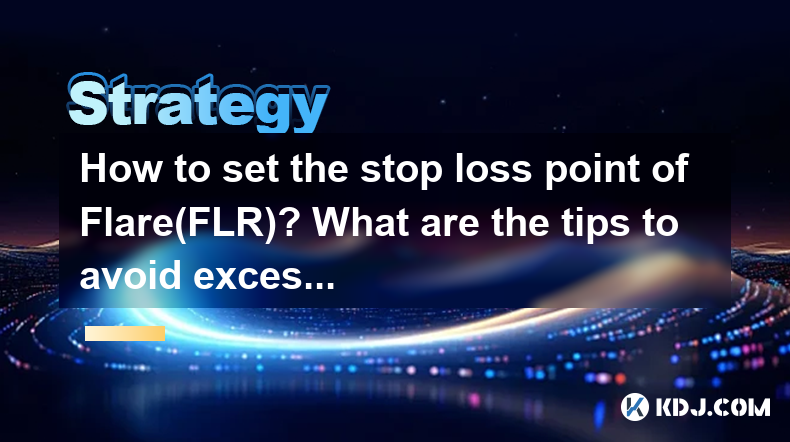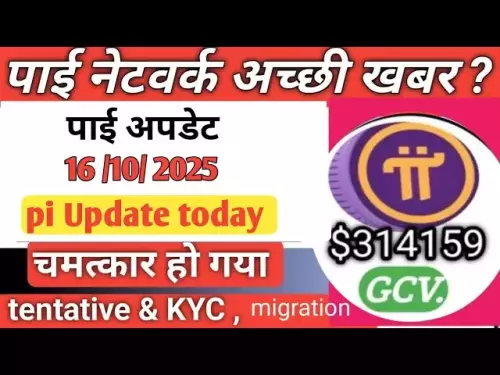-
 bitcoin
bitcoin $110918.433029 USD
-1.69% -
 ethereum
ethereum $3996.872473 USD
-2.43% -
 tether
tether $1.000594 USD
0.00% -
 bnb
bnb $1178.871834 USD
-2.38% -
 xrp
xrp $2.413973 USD
-3.47% -
 solana
solana $194.341461 USD
-4.24% -
 usd-coin
usd-coin $0.999963 USD
-0.03% -
 tron
tron $0.320092 USD
0.92% -
 dogecoin
dogecoin $0.196919 USD
-3.42% -
 cardano
cardano $0.669585 USD
-3.63% -
 hyperliquid
hyperliquid $37.485952 USD
-3.58% -
 ethena-usde
ethena-usde $1.000026 USD
-0.02% -
 chainlink
chainlink $18.018220 USD
-5.13% -
 bitcoin-cash
bitcoin-cash $523.879267 USD
-2.41% -
 stellar
stellar $0.324655 USD
-3.67%
How to set the stop loss point of Flare(FLR)? What are the tips to avoid excessive losses?
Setting a stop loss for Flare (FLR) is crucial; it helps manage risk by automatically selling when the price hits a predetermined level, protecting your investment.
Apr 30, 2025 at 02:21 pm

Understanding the Importance of Stop Loss in Cryptocurrency Trading
When trading cryptocurrencies like Flare (FLR), setting a stop loss is crucial for managing risk and protecting your investments. A stop loss is an order placed with a broker to buy or sell once the stock reaches a certain price. This tool helps traders limit their losses by automatically selling the asset when its price falls to a predetermined level. For Flare (FLR), understanding how to set an effective stop loss can be the difference between a manageable loss and a devastating one.
How to Set the Stop Loss Point for Flare (FLR)
Setting a stop loss for Flare (FLR) involves several steps that need to be carefully considered. Here's a detailed guide on how to do it:
Choose Your Trading Platform: First, ensure you are using a trading platform that supports stop loss orders. Most reputable exchanges like Binance, Coinbase Pro, and Kraken offer this feature.
Determine Your Risk Tolerance: Before setting a stop loss, assess your risk tolerance. Are you comfortable with a 5% loss, or would a 10% loss be more acceptable? This will help you decide the stop loss level.
Analyze Flare (FLR) Price Movements: Look at the historical price data of Flare (FLR). Use technical analysis tools to identify support and resistance levels. Setting a stop loss just below a significant support level can be a good strategy.
Set the Stop Loss Order: Once you have decided on the stop loss level, navigate to the trading interface of your chosen platform. Here's how to set it up:
- Go to the trading section for Flare (FLR).
- Select the 'Stop-Limit' order type.
- Enter the stop price, which is the price at which the stop loss will be triggered.
- Set the limit price, which is the price at which the order will be executed once the stop price is reached.
- Confirm the order.
Monitor and Adjust: Cryptocurrency markets are volatile, and prices can fluctuate rapidly. Regularly review and adjust your stop loss to ensure it remains relevant to current market conditions.
Tips to Avoid Excessive Losses with Flare (FLR)
Avoiding excessive losses when trading Flare (FLR) requires a combination of strategy, discipline, and continuous learning. Here are some tips to help you manage your risks effectively:
Use Technical Analysis: Employ technical analysis to identify trends and potential reversal points in Flare (FLR)'s price. Tools like moving averages, RSI, and MACD can help you make informed decisions about where to set your stop loss.
Diversify Your Portfolio: Don't put all your eggs in one basket. By diversifying your investments across different cryptocurrencies, you can mitigate the risk of a significant loss from a single asset like Flare (FLR).
Set Realistic Expectations: Understand that the cryptocurrency market is highly volatile. Set realistic profit and loss expectations to avoid making impulsive decisions that could lead to excessive losses.
Implement a Trailing Stop Loss: A trailing stop loss adjusts automatically as the price of Flare (FLR) moves in your favor. This can help you lock in profits while still protecting against significant downturns.
Stay Informed: Keep up with the latest news and developments related to Flare (FLR). Regulatory changes, technological updates, or shifts in market sentiment can all impact the price and should be considered when managing your stop loss.
Common Mistakes to Avoid When Setting Stop Loss for Flare (FLR)
Setting a stop loss for Flare (FLR) can be tricky, and traders often make mistakes that can lead to unnecessary losses. Here are some common pitfalls to avoid:
Setting the Stop Loss Too Tight: If your stop loss is too close to the current price, you risk being stopped out by normal market fluctuations. Ensure your stop loss gives Flare (FLR) enough room to move.
Ignoring Market Volatility: Cryptocurrency markets can be highly volatile. Failing to account for this volatility when setting your stop loss can result in premature selling.
Not Adjusting the Stop Loss: As the price of Flare (FLR) moves, your stop loss should be adjusted accordingly. Failing to do so can mean missing out on potential profits or not protecting against losses effectively.
Over-reliance on Stop Loss: While stop losses are essential, they should not be your only risk management tool. Combine them with other strategies like position sizing and diversification.
Practical Example of Setting a Stop Loss for Flare (FLR)
To illustrate how to set a stop loss for Flare (FLR), let's consider a practical example. Suppose you buy Flare (FLR) at $0.10 per token, and you are willing to risk a 10% loss. Here's how you would set up your stop loss:
Determine the Stop Loss Level: A 10% loss from $0.10 would be $0.09. This is your stop price.
Set the Stop-Limit Order: On your trading platform, you would set a stop-limit order with the stop price at $0.09 and the limit price slightly lower, say $0.089, to ensure the order is executed.
Monitor and Adjust: If Flare (FLR)'s price rises to $0.12, you might adjust your stop loss to $0.108 to lock in some profit while still protecting against a significant downturn.
Frequently Asked Questions
Q: Can I set a stop loss on all cryptocurrency exchanges?A: Not all cryptocurrency exchanges support stop loss orders. It's essential to check if your chosen platform offers this feature before trading.
Q: What is the difference between a stop loss and a stop-limit order?A: A stop loss order becomes a market order once the stop price is reached, meaning it will be executed at the next available price. A stop-limit order, on the other hand, becomes a limit order once the stop price is reached, meaning it will only be executed at the specified limit price or better.
Q: How often should I adjust my stop loss for Flare (FLR)?A: The frequency of adjusting your stop loss depends on your trading strategy and the volatility of Flare (FLR). As a general rule, review and adjust your stop loss whenever there are significant price movements or changes in market conditions.
Q: Is it possible to set a stop loss too far away from the current price?A: Yes, setting a stop loss too far away can result in larger losses than necessary. It's important to balance the need to give Flare (FLR) room to move with the need to protect your investment.
Disclaimer:info@kdj.com
The information provided is not trading advice. kdj.com does not assume any responsibility for any investments made based on the information provided in this article. Cryptocurrencies are highly volatile and it is highly recommended that you invest with caution after thorough research!
If you believe that the content used on this website infringes your copyright, please contact us immediately (info@kdj.com) and we will delete it promptly.
- Larry Fink and BlackRock: Tokenizing All the Assets, Baby!
- 2025-10-16 11:05:12
- Meme Coin Mania: MoonBull, FLOKI, and SHIB – What's the Buzz?
- 2025-10-16 09:10:00
- Pepeto's Presale Success: Riding the Crypto Bull Run Wave
- 2025-10-16 08:30:01
- Affordable GPUs for Gamers: A 2025 Deep Dive
- 2025-10-16 10:25:12
- Coinbase, BNB, and Token Listings: A New Era?
- 2025-10-16 09:25:16
- Secure Enclave, Flow, and Launch: What's the Buzz?
- 2025-10-16 08:30:01
Related knowledge

Practical parameter settings for a Bitcoin multi-timeframe moving average system
Sep 18,2025 at 10:54pm
Optimizing Timeframe Combinations for Bitcoin Trading1. Selecting appropriate timeframes is crucial when building a multi-timeframe moving average sys...

How can I filter out false breakouts in Dogecoin high-frequency trading?
Sep 22,2025 at 01:00am
Understanding False Breakouts in Dogecoin Trading1. A false breakout occurs when Dogecoin's price appears to move beyond a defined support or resistan...

Techniques for identifying tops and bottoms in the Bitcoin on-chain NVT model
Sep 20,2025 at 07:54pm
Understanding the NVT Model in Bitcoin Analysis1. The Network Value to Transactions (NVT) ratio is often described as the 'P/E ratio' of the cryptocur...

What does the surge in open interest in Bitcoincoin futures mean?
Sep 20,2025 at 11:18pm
Understanding the Surge in Dogecoin Futures Open Interest1. A surge in open interest within Dogecoin futures indicates a growing number of active cont...

How can I use the Ethereum USDT premium to gauge market sentiment?
Sep 18,2025 at 11:55pm
Understanding the Ethereum USDT Premium1. The Ethereum USDT premium refers to the price difference between USDT (Tether) traded on Ethereum-based plat...

What should I do if Ethereum staking yields decline?
Sep 20,2025 at 06:18am
Understanding the Causes Behind Declining Ethereum Staking Yields1. The Ethereum network transitioned to a proof-of-stake consensus mechanism with the...

Practical parameter settings for a Bitcoin multi-timeframe moving average system
Sep 18,2025 at 10:54pm
Optimizing Timeframe Combinations for Bitcoin Trading1. Selecting appropriate timeframes is crucial when building a multi-timeframe moving average sys...

How can I filter out false breakouts in Dogecoin high-frequency trading?
Sep 22,2025 at 01:00am
Understanding False Breakouts in Dogecoin Trading1. A false breakout occurs when Dogecoin's price appears to move beyond a defined support or resistan...

Techniques for identifying tops and bottoms in the Bitcoin on-chain NVT model
Sep 20,2025 at 07:54pm
Understanding the NVT Model in Bitcoin Analysis1. The Network Value to Transactions (NVT) ratio is often described as the 'P/E ratio' of the cryptocur...

What does the surge in open interest in Bitcoincoin futures mean?
Sep 20,2025 at 11:18pm
Understanding the Surge in Dogecoin Futures Open Interest1. A surge in open interest within Dogecoin futures indicates a growing number of active cont...

How can I use the Ethereum USDT premium to gauge market sentiment?
Sep 18,2025 at 11:55pm
Understanding the Ethereum USDT Premium1. The Ethereum USDT premium refers to the price difference between USDT (Tether) traded on Ethereum-based plat...

What should I do if Ethereum staking yields decline?
Sep 20,2025 at 06:18am
Understanding the Causes Behind Declining Ethereum Staking Yields1. The Ethereum network transitioned to a proof-of-stake consensus mechanism with the...
See all articles


























![Web3 Crypto Market Morning Report: The market is in decline, altcoins have fallen by more than 5%, Binance compensation has been received, and Memes on the Bnb chain have collectively plummeted [Vic TALK Issue 1444] Web3 Crypto Market Morning Report: The market is in decline, altcoins have fallen by more than 5%, Binance compensation has been received, and Memes on the Bnb chain have collectively plummeted [Vic TALK Issue 1444]](/uploads/2025/10/16/cryptocurrencies-news/videos/web-crypto-market-morning-report-market-decline-altcoins-fallen-binance-compensation-received-memes-bnb-chain-collectively-plummeted-vic-talk-issue/68f043c9c8b44_image_500_375.webp)















































